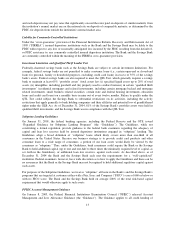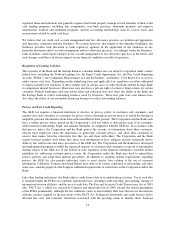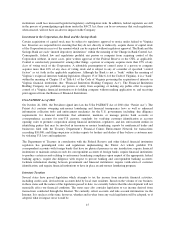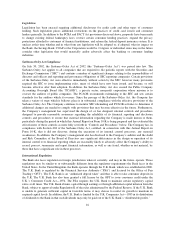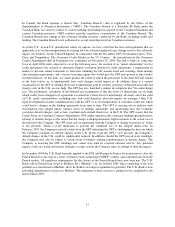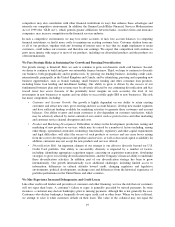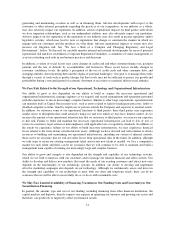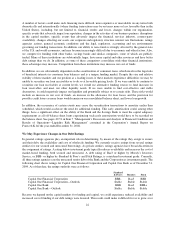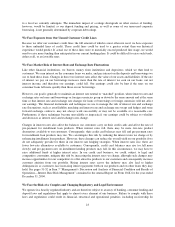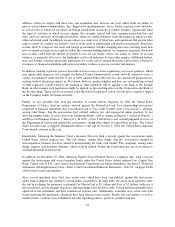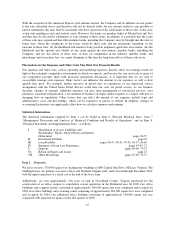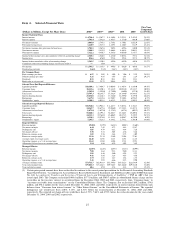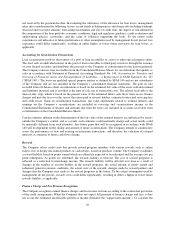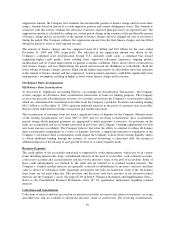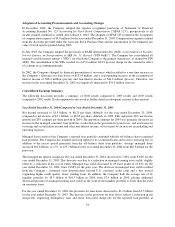Capital One 2004 Annual Report Download - page 46
Download and view the complete annual report
Please find page 46 of the 2004 Capital One annual report below. You can navigate through the pages in the report by either clicking on the pages listed below, or by using the keyword search tool below to find specific information within the annual report.to a level we currently anticipate. The immediate impact of a ratings downgrade on other sources of funding,
however, would be limited, as our deposit funding and pricing, as well as some of our unsecured corporate
borrowing, is not generally determined by corporate debt ratings.
We Face Exposure from Our Unused Customer Credit Lines
Because we offer our customers credit lines, the full amount of which is most often not used, we have exposure
to these unfunded lines of credit. These credit lines could be used to a greater extent than our historical
experience would predict. If actual use of these lines were to materially exceed predicted line usage, we would
need to raise more funding than anticipated in our current funding plans. It could be difficult to raise such funds,
either at all, or at favorable rates.
We Face Market Risk of Interest Rate and Exchange Rate Fluctuations
Like other financial institutions, we borrow money from institutions and depositors, which we then lend to
customers. We earn interest on the consumer loans we make, and pay interest on the deposits and borrowings we
use to fund those loans. Changes in these two interest rates affect the value of our assets and liabilities. If the rate
of interest we pay on our borrowings increases more than the rate of interest we earn on our loans, our net
interest income, and therefore our earnings, could fall. Our earnings could also be hurt if the rates on our
consumer loans fall more quickly than those on our borrowings.
However, our goal is generally to maintain an interest rate neutral or “matched” position, where interest rates and
exchange rates on loans and borrowings or foreign currencies go up or down by the same amount and at the same
time so that interest rate and exchange rate changes for loans or borrowings or foreign currencies will not affect
our earnings. The financial instruments and techniques we use to manage the risk of interest rate and exchange
rate fluctuations, such as asset/liability matching and interest rate and exchange rate swaps and hedges and some
forward exchange contracts, may not always work successfully or may not be available at a reasonable cost.
Furthermore, if these techniques become unavailable or impractical, our earnings could be subject to volatility
and decreases as interest rates and exchange rates change.
Changes in interest rates also affect the balances our customers carry on their credit cards and affect the rate of
pre-payment for installment loan products. When interest rates fall, there may be more low-rate product
alternatives available to our customers. Consequently, their credit card balances may fall and pre-payment rates
for installment loan products may rise. We can mitigate this risk by reducing the interest rates we charge or by
refinancing installment loan products. However, these changes can reduce the overall yield on our portfolio if we
do not adequately provide for them in our interest rate hedging strategies. When interest rates rise, there are
fewer low-rate alternatives available to customers. Consequently, credit card balances may rise (or fall more
slowly) and pre-payment rates on installment lending products may fall. In this circumstance, we may have to
raise additional funds at higher interest rates. In our credit card business, we could, subject to legal and
competitive constraints, mitigate this risk by increasing the interest rates we charge, although such changes may
increase opportunities for our competitors to offer attractive products to our customers and consequently increase
customer attrition from our portfolio. Rising interest rates across the industry may also lead to higher
delinquencies as customers face increasing interest payments both on our products and on other loans they may
hold. See pages 51-52 in Item 7 “Management’s Discussion and Analysis of Financial Condition and Results of
Operations—Interest Rate Risk Management” contained in the Annual Report on Form 10-K for the year ended
December 31, 2004.
We Face the Risk of a Complex and Changing Regulatory and Legal Environment
We operate in a heavily regulated industry and are therefore subject to an array of banking, consumer lending and
deposit laws and regulations that apply to almost every element of our business. Failure to comply with these
laws and regulations could result in financial, structural and operational penalties, including receivership. In
23


